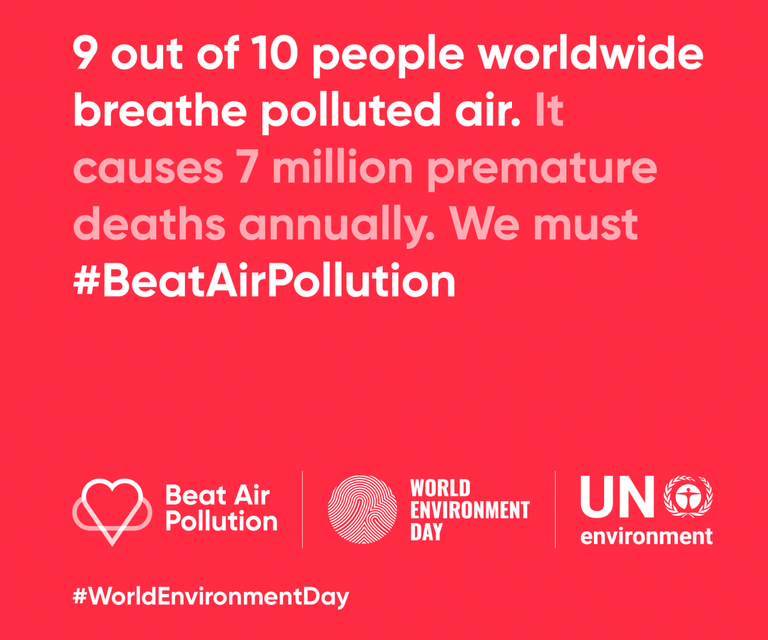World Environment Day 2019: “Beat Air Pollution”
There is a widely held perception that land-based human activities are the only cause of air quality degradation. In the public’s perception, industrial plants and automobile exhaust pipes spewing black smoke are associated with air pollution, not ships. Yet, vessels carry today an estimated 80 per cent of all goods traded in the world. In 2017, the global maritime transport fleet grew by 3.15 per cent in terms of deadweight tonnage and by 2.47 per cent in terms of number of vessels (compared to 2016). Maritime transport is the backbone of international trade and an important source of pollution with adverse impacts on human health and ecosystems.
The Mediterranean Sea is host to the world’s busiest shipping lanes and is the second busiest cruising region in the world after the Caribbean with 15.8 per cent of global cruise fleet deployment in 2017 (MedCruise Association, 2018). Ship movements, which often occur close to the densely populated coasts of the Mediterranean countries, result in emissions of toxic gases and Particulate Matter (PM) from fuel combustion, including sulphur oxides (SOx).
SOx emissions contribute to the formation of sulphate (SO4) aerosols which, along with other types of PM, are able to penetrate deep into the lungs of humans and all living organisms. Exposure to such pollutants is linked to lung cancer, cardiovascular illnesses and asthma. Ecosystems suffer from the deposition of SO4 particles which increase acidification of surface water and soil. Sulphate also takes a toll on human-made buildings and infrastructure, including vulnerable world heritage sites. At certain concentrations in the air, SO4 increases haze and reduces visibility.
The UN Environment /Mediterranean Action Plan – Barcelona Convention system is working with the Contracting Parties on what could well become a sea change on air quality in the Mediterranean. We have been considering an adequate regime to cut ship emissions since the early 2000s, but we have never been closer to a breakthrough. This year’s Meeting of the Contracting Parties (COP 21) in Naples will examine, for the first time, the possibility of designating the Mediterranean Sea or parts thereof as an Emission Control Area (ECA) under Annex VI of the International Convention for the Prevention of Pollution from Ships (MARPOL).
Under MARPOL, countries bordering a specific sea basin can request the International Maritime Organization (IMO) to designate that sea as an Emission Control Area for sulphur oxides (SOx ECAs). So far, the Baltic and North Sea as well as the North American coasts have been designated as SOx ECAs by IMO. We hope that the Mediterranean Sea will be next.
On 1 January 2020, an IMO requirement will reduce the sulphur content permitted in ships fuel-oil globally from 3.5 per cent to 0.5 per cent, except in SOx ECAs where ships are required to use fuel with just 0.10 per cent sulphur. A feasibility study commissioned by REMPEC on behalf of the Contracting Parties to the Barcelona Convention recently established that the designation of the Mediterranean Sea area, as a SOx ECA (the proposed Med ECA) would lower emissions by 78.7 per cent for SOx and 23.7 per cent for PM2.5, when comparing to the expected emissions of the relevant pollutants in the scenario where only the IMO sulphur cap (0.5 per cent) is in place.
The incentives for taking bold action on curbing air pollution from ships in the Mediterranean are compelling. In addition to reducing lung cancer and cardiovascular disease mortality, air quality modelling used in the REMPEC study shows widespread reductions in wet and dry SOx and PM depositions with positive impacts on aquatic systems. The designation of the proposed Med ECA would increase aerosol optical depth, a physical phenomenon associated with reduced haze and improvements in visibility. Improvements in visibility would notably be felt over the Straits of Gibraltar, northern Morocco and Algeria, and along the main shipping lane connecting the Straits of Gibraltar to the Suez. They would also extend far inland over North Africa.
REMPEC submitted a draft road map as well as an initial draft submission to the IMO for review and consideration, to the 13th Meeting of its Focal Points to be held in Floriana, Malta, on 11-13 June 2019. The draft road map will then be considered by the 13th Meeting of the Focal Points of UN Environment/MAP prior to a potential adoption at COP 21 (Naples, Italy, 2-5 December 2019).
If this process comes to fruition, the submission of a joint and coordinated proposal to the IMO for the designation of the proposed Med ECA could be made in 2022, with a possible entry into force of the related amendment to MARPOL Annex VI some time after March 2024. With the ancillary benefits that it may carry for climate change mitigation efforts, the Med ECA would be a huge leap forward for the entire region and a significant accomplishment in the implementation of the 2030 Agenda for Sustainable Development.
There is hope in the air.
--------------
Useful resources:
Visit the World Environment Day (WED, 5 June) page and take part in the global #BeatAirPollution Campaign by using the WED 2019 practical guide.
Explore UN Environment’s work to improve air quality to protect the environment and human health
Read the IMO article Sulphur 2020 – cutting sulphur oxide emissions

